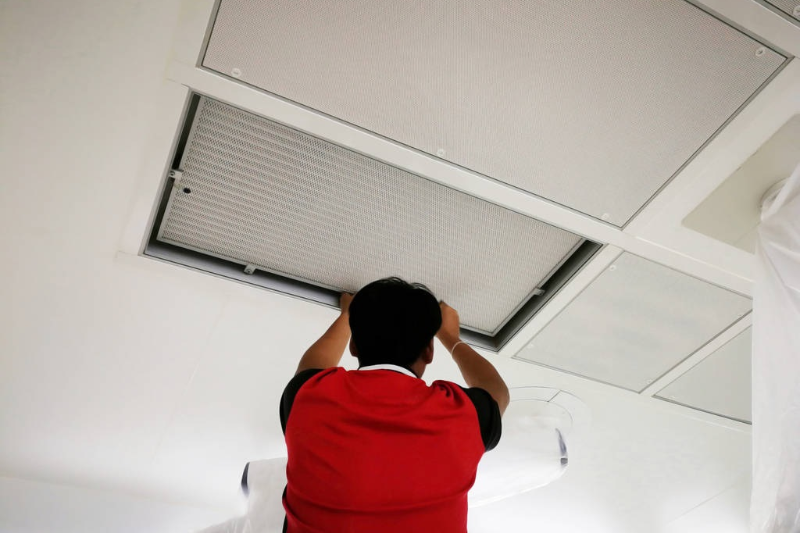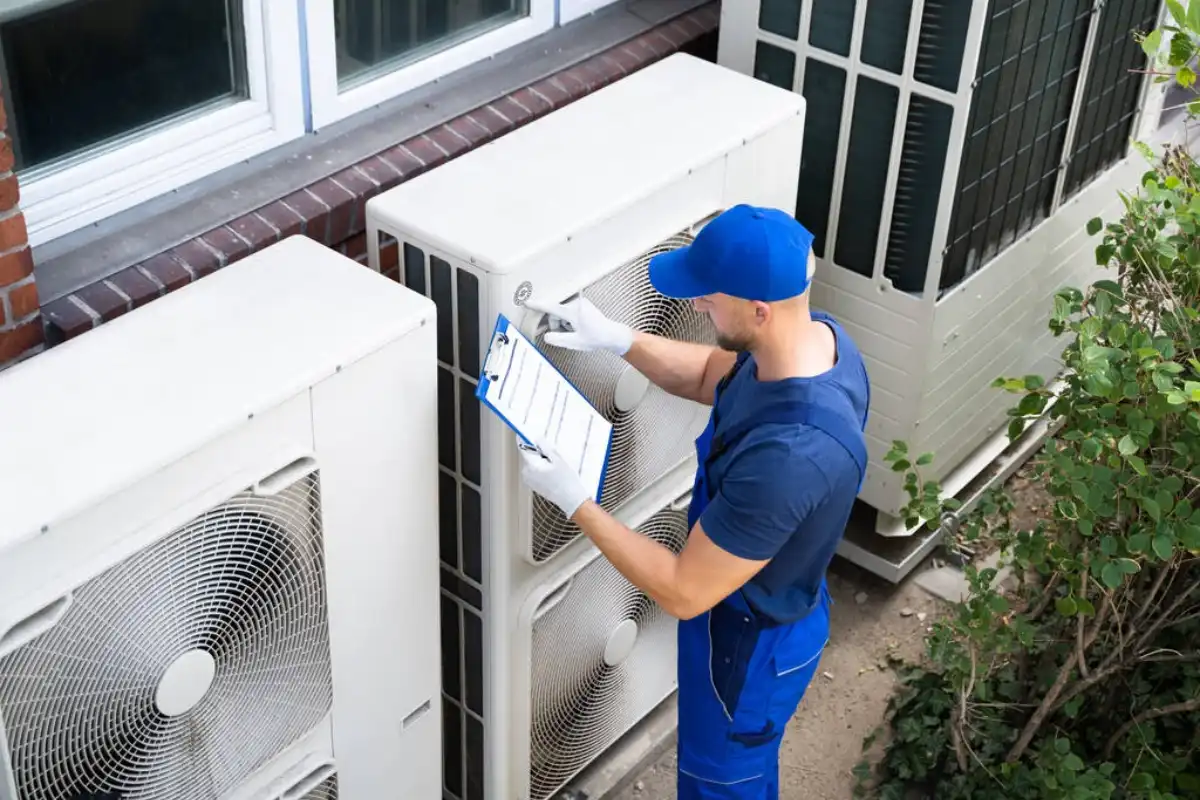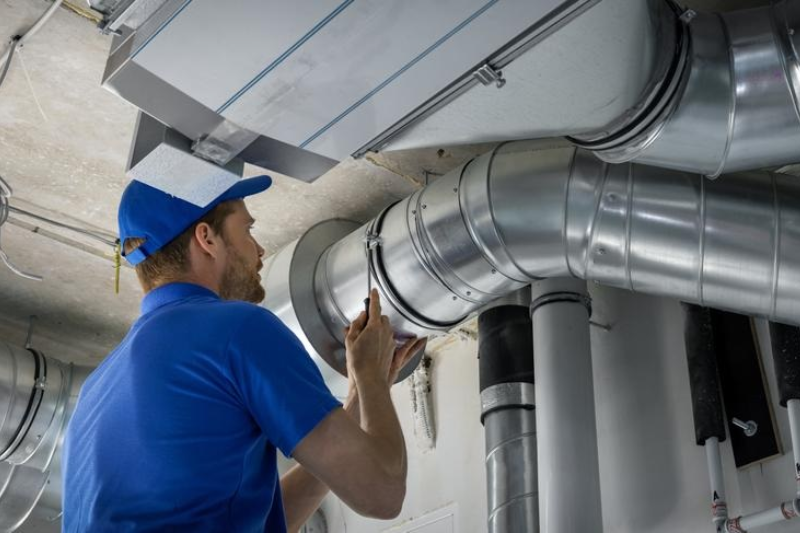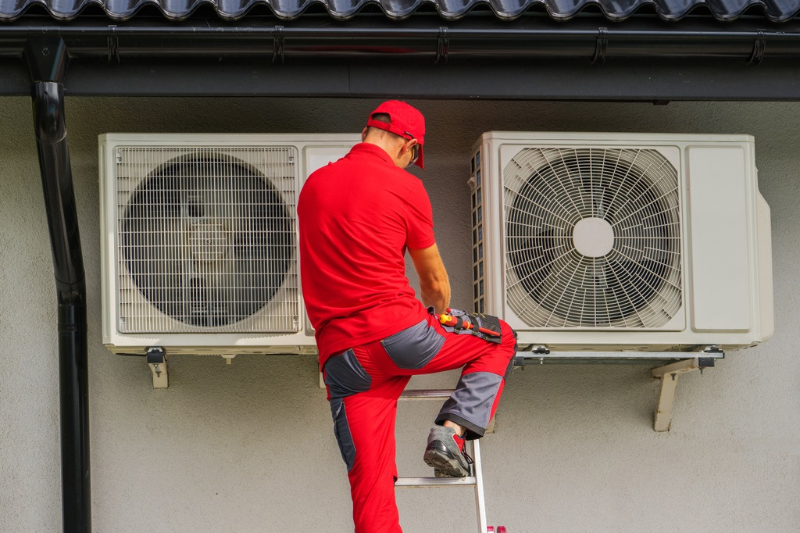Table Of Contents
Imagine coming home on a scorching summer day, and the moment you step inside, you’re enveloped in a cool, refreshing breeze. That’s the magic of ducted air conditioning systems.
In this article, we’ll dive deep into the inner workings of these ducted systems, demystifying the technology that keeps our residential property’s and commercial offices comfortably cool. Read on for more!
Components of a Ducted Air Conditioning System

Central air conditioning unit
At the heart of every ducted air conditioner is the central unit. This powerhouse is responsible for cooling the air before distributing it throughout your space. It contains vital components like the compressor, evaporator, and condenser, which work together to make the magic happen.
Ductwork
The ductwork is like the circulatory system of your cooling setup. It’s a network of pipes or channels that carries the conditioned air from the central unit to different rooms. These ducts can be hidden within your walls, ceiling, or floor, ensuring a seamless and unobtrusive cooling experience.
Air vents and registers
Air vents and registers are the gatekeepers of comfort. They regulate the airflow into each room. Adjustable dampers within them allow you to fine-tune the temperature, ensuring that no space is too hot or too cold.
Thermostat and control system
Modern ducted air conditioning systems come with smart thermostats that give you precise control over your indoor climate. You can set temperature schedules, create cooling zones, and even control your system remotely through your smartphone.
Return air grille
The return air grille plays a crucial role in the system’s efficiency. It collects warm air from your rooms, sends it back to the central unit for cooling, and then redistributes the refreshed air. This cycle ensures a constant supply of cool, clean air.
The Cooling Process

Refrigeration cycle
At the core of any air conditioning system is the refrigeration cycle. It’s a continuous process of compressing and expanding a refrigerant gas to absorb and release heat. This cycle allows your ducted system to remove warm air and replace it with cool, refreshing air.
Role of the compressor
The compressor is the workhorse of the system. It pressurises the refrigerant, causing it to become hot and high in energy. This high-energy gas flows through the system, releasing heat as it condenses into a liquid.
Evaporation and condensation
As the liquid refrigerant goes through the evaporator coil, it absorbs heat, causing it to evaporate into a gas again. This process cools the air in your home. The now-hot refrigerant gas moves to the condenser coil and releases heat, becoming a liquid once more.
Heat exchange in the units
Ducted systems consist of both indoor and outdoor units. The indoor unit cools the air inside, while the outdoor unit disperses the absorbed heat outside. This dual-unit design ensures efficient cooling and keeps your indoor space comfortable.
Importance of refrigerant
The choice of refrigerant matters for both performance and environmental reasons. Modern systems use environmentally friendly refrigerants with lower global warming potential, reducing their environmental impact.
Air Filtration and Purification

Air Filters in ducted systems
Ducted air cons aren’t just about cooling; they also improve indoor air quality. They come equipped with air filters that capture dust, allergens, and pollutants, ensuring the air you breathe is clean and healthy.
Removing dust and particles
These filters trap dust and particles effectively, preventing them from circulating through your home. This not only keeps your living space clean but also extends the life of your system by reducing wear and tear.
Filtering out allergens and pollutants
If you suffer from allergies, a ducted system can be a game-changer. The filters capture allergens like pollen and pet dander and indoor pollutants like smoke and odours.
Improving indoor air quality
By removing these airborne irritants, ducted systems create an environment where you can breathe easily. They’re particularly beneficial for households with children, the elderly, or anyone with respiratory sensitivities.
Maintenance and replacement of filters
Regular maintenance ensures the air conditioner operates at peak efficiency, delivering optimal cooling and air quality.
Ductwork and Air Distribution

Duct material and design
The choice of duct material and design is vital to the efficiency of your system. Well-designed and adequately insulated ducts minimise energy loss and ensure the conditioned air reaches its destination.
Supply and return ducts
Ducted systems have both supply and return ducts. Supply ducts carry the cool air into rooms, while return ducts collect warm air to be cooled again. Balancing the airflow between these ducts is essential for maintaining a consistent temperature.
Zoning and multiple zones
One of the standout features of ducted systems is zoning. This allows you to divide your space into zones, each with its thermostat. You can customise the temperature in different areas of the split systems, optimising comfort and energy efficiency.
Balancing air distribution
Balancing the airflow ensures that each room receives the right amount of conditioned air. Professional installation and regular maintenance help keep the distribution system in check, preventing hot or cold spots.
Duct insulation for energy efficiency
Proper insulation of the ductwork is critical for energy efficiency. Well-insulated ducts prevent heat exchange with the surrounding environment, minimising energy waste and reducing utility bills.
Temperature and Humidity Control

Thermostat settings and programming
Modern ducted systems offer precise temperature control through advanced thermostats. You can set your desired temperature and create customised schedules to match your daily routine. This level of control ensures that your space is always at the perfect temperature.
Monitoring and adjusting humidity levels
Some ducted systems also allow you to monitor and adjust indoor humidity levels. Proper humidity is crucial for comfort and health, as excessively dry or humid air can cause problems like dry skin or mould growth.
Maintaining consistent temperatures
Unlike traditional window units or portable ACs, ducted systems maintain consistent temperatures throughout your space. No more hot spots near the window or chilly corners – your room stays comfortable.
Energy-saving features
Ducted systems often come with energy-saving features like sleep mode and occupancy sensors. These intelligent functions adjust the cooling based on your activity, reducing energy consumption and lowering utility bills.
Compatibility with smart home systems
Want to control your cooling system with a voice command or through a smartphone app? Many ducted systems integrate seamlessly with smart home platforms, offering a convenient and futuristic way to manage your indoor climate.
Energy Efficiency and Cost Savings
SEER and EER ratings
When shopping for a ducted system, consider its Seasonal Energy Efficiency and Energy Efficiency Ratio ratings. Higher ratings indicate better energy efficiency, which translates to lower operating costs.
Proper sizing of the system
Getting the right-sized system for your space is essential. Oversized units can lead to short cycling and inefficient operation, while an undersized unit will struggle to cool adequately. Professional HVAC technicians perform load calculations to ensure proper sizing.
Insulation and sealing of ducts
Energy efficiency isn’t just about the central unit but also the ductwork. Well-insulated and properly sealed ducts prevent air leakage, which can waste energy and reduce cooling effectiveness.
Long-term cost benefits
While the initial cost of installing a ducted system might be higher than other cooling solutions, the long-term cost benefits are substantial. Energy-efficient operation and lower maintenance costs can save you money over the system’s life.
Advantages of Ducted Air Conditioning

Uniform cooling throughout the space
Ducted systems provide uniform cooling, eliminating hot and cold spots. Every corner of your home or office enjoys the same level of comfort.
Aesthetic appeal with hidden vents
Unlike bulky window also known as box air conditioning units or wall-mounted ACs, ducted systems are discreet. The vents and registers are hidden, preserving the aesthetic appeal of your interior design.
Reduced noise levels
Ducted systems operate quietly. You’ll barely notice them running, creating a peaceful, undisturbed indoor environment.
Enhanced climate control with zoning
Zoning capabilities allow you to tailor the climate in different areas of your space. No need to cool rooms you’re not using, saving energy and money.
Improved energy efficiency
Combining advanced technology, precise temperature control, and energy-efficient components makes ducted systems one of the most eco-friendly cooling options.
Installation and Maintenance
Professional installation process
Installing a ducted system is a complex task best left to professionals. They’ll ensure the system is correctly sized, installed, and balanced for optimal performance.
Routine maintenance tasks
Regular maintenance includes:
- Cleaning or replacing filters.
- Checking refrigerant levels.
- Inspecting ducts.
- Ensuring all components are in top shape.
This routine upkeep is essential for keeping your system running smoothly.
Common issues and troubleshooting
Knowing how to troubleshoot common issues, like uneven cooling or unusual noises, can help you identify problems early and prevent costly repairs.
When to seek professional assistance
While DIY maintenance can handle some tasks, there are times when you’ll need the expertise of HVAC professionals. Timely intervention can prevent minor issues from escalating.
Extending the lifespan of the system
Proper care and maintenance ensure efficient operation and extend your ducted system’s lifespan, giving you years of reliable cooling.
Considerations and Tips for Buyers

Sizing the system for your space
Consult with HVAC professionals to determine the appropriate size for your ducted system. Avoid the common mistake of choosing a unit solely based on price.
Energy efficiency incentives and rebates
Look into local or federal incentives and rebates for energy-efficient HVAC systems. These can significantly offset the initial cost.
Choosing the right thermostat
Invest in a thermostat that suits your needs and preferences. Modern thermostats offer features like Wi-Fi connectivity, voice control, and programmable schedules.
Exploring additional features
Explore additional features that may enhance your comfort, such as air purification systems, dehumidifiers, or smart home integration.
Comparing quotes from HVAC contractors
Don’t just focus on the price when obtaining quotes from HVAC contractors. Consider factors like reputation, experience, and the quality of their workmanship.
Environmental Impact and Sustainability
Refrigerants and their environmental impact
Be aware of the type of refrigerant your ducted system uses. Newer systems employ environmentally friendly refrigerants with reduced global warming potential.
Eco-friendly refrigerant alternatives
If you’re environmentally conscious, ask about ducted systems using alternative refrigerants with minimal environmental impact.
Energy-efficient operation and reduced carbon footprint
By operating efficiently and reducing energy consumption, ducted systems contribute to lower carbon emissions, helping combat climate change.
Proper disposal and recycling of old units
When replacing your old ducted system, ensure it’s disposed of properly or recycled to minimise environmental impact.
Take Control of Your Comfort Today
Now that you’ve uncovered the inner workings of ducted air conditioning, it’s time to take control of your comfort. Whether you’re considering installation, upgrading your existing system, or simply optimising your current setup, make informed decisions to ensure a more comfortable, efficient, and cost-effective indoor environment.
Don’t let the heat of summer or the chill of winter dictate your comfort. With ducted air conditioning, you can create a haven of perfect temperatures throughout your home. Start exploring your options, schedule a professional assessment, and embark on the journey to a more comfortable and enjoyable living space with a ducted air conditioner.



